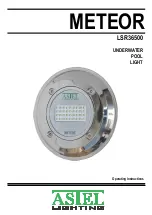
USE ONLY HAYWARD GENUINE REPLACEMENT PARTS
9
Troubleshooting
Motor Will NOT Start – Check For:
1.
Improper or loose wiring connections; open switches or relays; tripped circuit breakers, GFCI’s, or blown fuses.
2.
Manually check rotation of motor shaft for free movement and lack of obstruction. (See steps 4 & 5 of “Shaft
Seal Change Instructions” in this manual.)
3.
If you have a timer, be certain it is working properly. Bypass it if necessary.
Motor Shuts OFF – Check For:
1.
Undersized wiring; loose connections; etc.
2.
Low voltage at motor or power drop (frequently caused by undersized wiring or extension cord use).
3.
Mechanical binding and electrical overload.
NOTE:
Your Hayward pump motor is equipped with an “automatic thermal overload protector.” The motor will
automatically shut off if power supply drops before heat damage can build up causing windings to burn out. The
“thermal overload protector” will allow the motor to automatically restart once the motor has cooled, provided the
power source is again up to proper levels. It will continue to cut On/Off until the problem is corrected. Be sure to
correct cause of overheating.
Motor Hums, But Does NOT Start – Check For:
1.
Centrifugal switch stuck in OPEN position.
2.
Binding of motor shaft.
Pump Won’t Prime
1.
Make sure pump/strainer housing is filled with water and the cover O-ring is clean, also be sure it is properly
seated in the cover O-ring groove. Make sure strainer cover is locked firmly in position and lubricated with
“Jack’s 327.”
2.
Make sure all suction and discharge valves are fully open and not blocked, that pool water level is at proper
level, and that skimmer weir is not hung up or stuck on skimmer wall.
3.
Block off to determine if pump will develop a vacuum. You should have 5”-6” of vacuum at the strainer cover
(Only your pool dealer can confirm this with a vacuum gauge). You may be able to check by removing the
skimmer basket and holding your hand over the bottom port with skimmer full and pump running. If no suction
is felt, check for line blockage.
a.
If pump develops a vacuum, check for blocked suction line or dirty strainer basket, an air leak in the
suction piping may be the cause.
b.
If pump does not develop a vacuum and pump has sufficient “priming water”:
i.
Re-check strainer housing cover and all threaded connections for suction leaks. Check if all
hose clamps are tight.
ii.
Check voltage to ensure that the motor is rotating at full RPM’s.
iii.
Open housing cover and check for clogging or obstruction in suction. Check impeller for debris.
iv.
Remove and replace shaft seal only if it is leaking.
Low Flow – Generally, Check For:
1.
Clogged or restricted strainer or suction line; undersized pool piping.
2.
Plugged or restricted discharge line of filter, valve partially closed (high gauge reading).
How to correct: Sand filters – backwash as per manufacturer’s instructions; D.E. filters – backwash as per
manufacturer’s instructions; Cartridge filters – clean or replace cartridge.
3.
Air leak in suction (bubbles issuing from return fittings). Re-tighten using Teflon tape.
4.
Plugged or restricted impeller or impeller sheared off. Replace including new seal assembly.

























